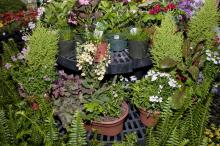Information Possibly Outdated
The information presented on this page was originally released on March 11, 2010. It may not be outdated, but please search our site for more current information. If you plan to quote or reference this information in a publication, please check with the Extension specialist or author before proceeding.
Follow tips to grow beautiful landscapes
Do you ever wonder how some people manage to have such beautiful plants in their gardens? You may think they shop somewhere special you’ve never heard about and know deep gardening secrets, but you, too, can create an inspiring landscape and grow beautiful and healthy plants.
It all begins with selecting healthy specimens at the local nursery or garden center. Look for plants that have strong branches with no crossed limbs and straight and sturdy trunks. The leaves should be of normal size, shape and color for that plant species.
Most plants that homeowners purchase are grown in small plastic containers. Check for healthy white roots and avoid girdled or pot-bound plants. To do this, carefully remove the plant from the container and examine the roots. Avoid plants with mechanical or insect damage and those with weeds in the container. You don’t need to bring home any extra problems in the landscape.
Buy plants that are suited for your growing region and that are known to have disease resistance to help ensure your success.
Deciding where to place your new plant in the landscape is also crucial to its success. You must know if the plant prefers sun or shade, wet or dry areas, and clay or sandy soils. Find out how big the plant will get, how fast it will grow and what its mature form will be. You need to know if it blooms, has fruit, has good fall color or is subject to insect or disease problems.
This information should not discourage you from trying a new plant, but rather help you plan for its proper maintenance. Putting the right plant in the right place will eliminate most problems.
Another step in growing beautiful landscape plants is proper preparation of the planting area. Amend your soil so that it will hold enough moisture while allowing adequate drainage. How you amend will depend on your current soil structure. A complete, slow-release fertilizer will provide nutrients the plant needs to flourish throughout the growing season.
Dig the planting hole two to three times wider than the root-ball but no deeper. Set the plant in place and backfill with the amended soil. Water well. Use a root-stimulator fertilizer at planting time to increase the plant’s chance of survival. Complete the project by adding a 2-to 4-inch layer of mulch to conserve moisture, suppress weeds and add beauty.
Don’t let the plant dry out before it is planted. Once it is in the ground, remember that plants do better with heavy, infrequent watering than light, daily applications. Too-light watering is a common mistake with home gardeners, but deep watering results in deep roots.
Follow these tips and you, too, can grow beautiful landscape plants. Good luck, and get growing.








